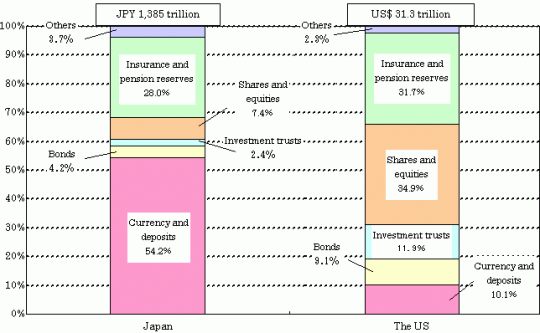Significance of Real Property Securitisation
Historically, more than half of the approximately JPY 1,400 trillion2 of financial assets owned by individuals in Japan has been in the form of deposits and savings. Compared to the United States, shares of stocks, investment trusts and bonds in individuals’ financial assets have been quite low (see Chart 1). Financial assets owned by individuals in Japan tend to accumulate in banks in the form of personal savings and deposits and are then lent by the banks to the corporate sector for production and investment purposes.
Until the end of the bubble period, loans to corporate borrowers were secured against the unrealised market value of their real property holdings. The so-called “Myth of Lands” – that real property was the most lucrative investment asset – led to the expectation that land values would increase continually.
However, since the burst of the bubble economy, caused by the decrease of asset values, this method of securing loans -known as the “land standard system” – has collapsed. In the future, it is unlikely that bank loans will be used as extensively for raising corporate capital, as was the case in the past. Therefore, it will be necessary to alter the existing behaviour pattern from one in which the majority of financial assets owned by individuals are invested in deposits and savings, to one in which more of such financial assets will be invested in products with a higher risk/return profile.
2 US$ = JPY (Japanese Yen) 118 (as of 20 September 2001). JPY 1,400 trillion = US$ 11.9 trillion (11,900 billion)
Chart 1 Asset Distribution of Households (as of end of September 2000)

Source: prepared by Ministry of Land, Infrastructure and Transport from the “Flow of Funds – Japan and US Overview” by the Bank of Japan
For investors and developers in Japan, it has become difficult to assume all the risks associated with direct property investment due to the heightened risks associated with the long-term nature of such investment and the substantial amount of funds generally required to invest in real property. Therefore, it would be beneficial to develop a new source of real property capital to supplement the traditional corporate source of real property capital.
In view of the above, real property securitisation affords the following significant benefits:
- Real property securitisation is a structure that allows investors to provide funds directly to businesses engaged in real property pursuits and to raise, through the purchase of standardized investment units, the substantial amount of funds required for property investment. In the process, property investment will be transformed from an activity in which participation by individuals has been difficult into something in which individuals, even those with limited funds, will be able to readily participate. Through such participation, individuals may have the opportunity to improve their asset portfolios that are currently unbalanced by the over-emphasis on deposits and savings; and
- Real property securitisation will generate a new source of funds for real property, resulting in the revitalisation of the real property industry and contributing to the modernization and improvement of urban areas through the increased infrastructure development, attributable to increased private-sector property activity.
Furthermore, real property securitisation will help to establish a more transparent real property market. Each securitised real property transaction will be reviewed and analysed by many investors and prospective investors following disclosure to them of the information to enable them to make appropriate investment decisions. Also, by promoting real property activity, real property securitisation is expected to make the real property market in Japan more liquid.
